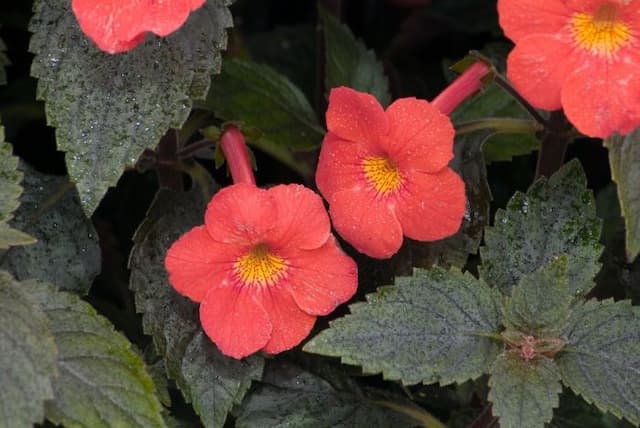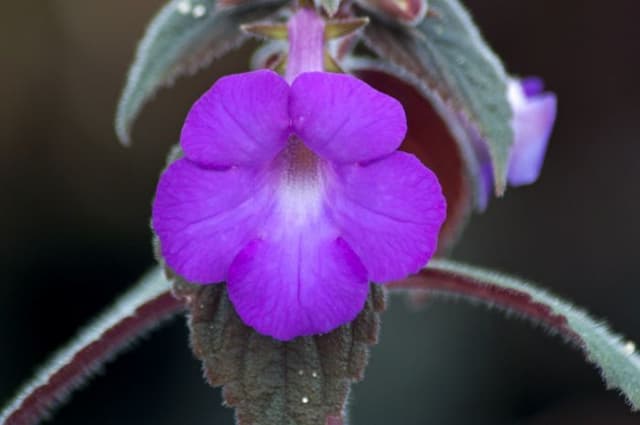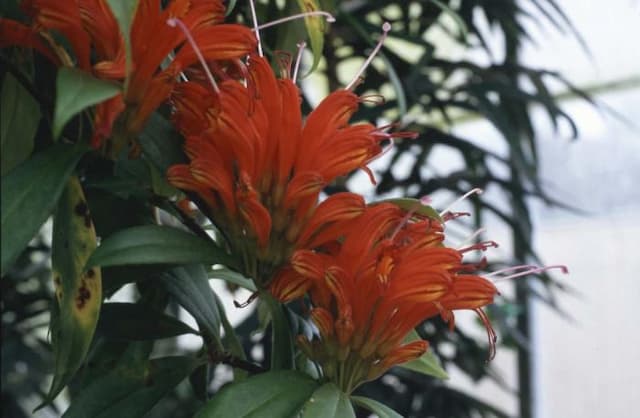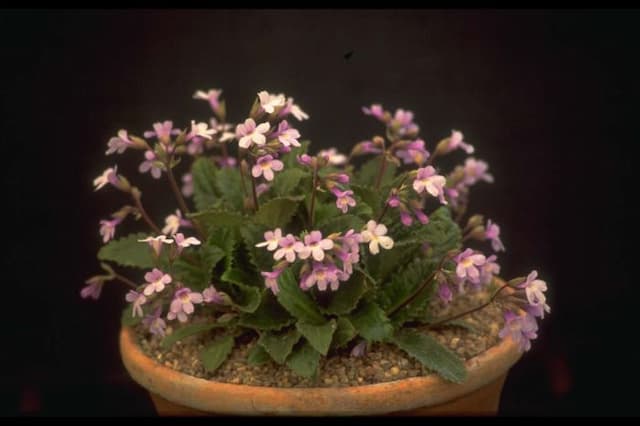Cape Primrose Streptocarpus 'Snow White'

ABOUT
Streptocarpus 'Snow White' is a striking flowering houseplant known for its lush, velvety foliage and stunning blooms. The leaves are a deep green, elongated, and textured with prominent veins, giving them a robust and full-bodied appearance. These leaves often form a basal rosette, from which emerges a slender flowering stem. The plant's most captivating feature is its dazzling white flowers, which are characterized by their delicate and trumpet-like shape, with a base that fans out into five distinct lobes. The throat of the flower, or the inner part, may exhibit faint yellow or purple markings that provide a subtle contrast to the snowy petals. These blossoms are soft to the touch, with a gentle, almost translucent quality to the white petals, imparting an ethereal look to the overall display. When in bloom, the contrast between the dark foliage and the pure white flowers of the Streptocarpus 'Snow White' creates a lovely visual harmony that's both eye-catching and soothing. This plant maintains a neat appearance, without reaching any great size, which makes it an excellent choice for adding a touch of elegance to small spaces without overtaking the area.
About this plant
 Names
NamesFamily
Gesneriaceae
Synonyms
Cape Primrose, African Violet
Common names
Streptocarpus 'Snow White'
 Toxicity
ToxicityTo humans
The Cape primrose (Streptocarpus 'Snow White') is generally considered non-toxic to humans. Therefore, if ingested, it is not expected to cause any significant symptoms of poisoning. However, like with any non-food plant, ingestion may cause mild gastrointestinal discomfort, including nausea or diarrhea.
To pets
The Cape primrose (Streptocarpus 'Snow White') is also non-toxic to pets. It should not cause serious symptoms if ingested by animals such as cats or dogs. Nevertheless, ingestion may still result in mild gastrointestinal irritation, which can include symptoms such as vomiting or diarrhea. It is always best to prevent pets from eating plants, as individual sensitivities can vary.
 Characteristics
CharacteristicsLife cycle
Perennials
Foliage type
Evergreen
Color of leaves
Green
Flower color
White
Height
1 foot (30 cm)
Spread
1 foot (30 cm)
Plant type
Herb
Hardiness zones
10
Native area
Africa
Benefits
 General Benefits
General Benefits- Easy to care for: Streptocarpus 'Snow White', also known as Cape Primrose, is known for its low maintenance requirements, making it ideal for busy plant owners.
- Long blooming period: It can bloom for several months of the year, providing a long-lasting display of flowers.
- Attractive foliage: The plant has attractive, velvety leaves that add a lush green texture to indoor spaces.
- Compact growth: With its compact growth habit, Streptocarpus 'Snow White' can fit into smaller spaces, perfect for apartments and small homes.
- Variety of colors: Although 'Snow White' suggests a white bloom, Streptocarpus comes in a wide variety of colors, offering many aesthetic options.
- Non-toxic to pets: It is considered non-toxic to cats and dogs, which makes it safe to keep in a household with pets.
- Adaptability: Streptocarpus 'Snow White' adapts well to a variety of indoor lighting conditions, from moderate light to bright, indirect sunlight.
- Enhances home decor: With its elegant flowers and leaves, it enhances home decor, adding a splash of natural beauty to any room.
 Medical Properties
Medical PropertiesThis plant is not used for medical purposes.
 Air-purifying Qualities
Air-purifying QualitiesThis plant is not specifically known for air purifying qualities.
 Other Uses
Other Uses- Cape Primrose can be used in miniature fairy gardens as it has delicate flowers that lend a whimsical touch to tiny settings.
- Its attractive blooms can be used in corsages or as a natural adornment for gift wrapping, adding an elegant touch to presents.
- Pressed flower crafts, such as making bookmarks or decorating homemade cards, can utilize the colorful petals of Cape Primrose.
- It serves as a decorative table centerpiece for special occasions, such as weddings or dinner parties, especially when planted in ornate pots.
- Plant photography enthusiasts may use Cape Primrose as a subject for macro photography due to its intricate flower details.
- In classrooms, the plant can be used for teaching children about botany and the lifecycle of plants in a hands-on manner.
- Artists can use the plant as inspiration or a live model for botanical illustration and painting practices.
- As part of a living plant wall or vertical garden, especially in areas with indirect light, it adds diversity in color and texture.
- When potting or repotting, the plant's attractive leaf veins can be cast in concrete or plaster to create botanical relief art pieces.
- Small-scale growers may use this plant to practice and perfect their propagation skills, as it can be grown from leaf cuttings.
Interesting Facts
 Feng Shui
Feng ShuiThe Cape Primrose is not used in Feng Shui practice.
 Zodiac Sign Compitability
Zodiac Sign CompitabilityThe Cape Primrose is not used in astrology practice.
 Plant Symbolism
Plant Symbolism- Purity: Given its name 'Snow White', this Streptocarpus variety is often associated with purity and innocence, similar to the untouched snow.
- Delicateness: The tender and delicate flowers of the Streptocarpus 'Snow White' come to symbolize gentle emotions and a sensitive nature.
- New Beginnings: White flowers typically signify new beginnings and fresh starts, making this plant a meaningful gift for those embarking on new endeavors.
- Serenity: The clean and peaceful appearance of the white flowers promotes a sense of calmness and serenity in the environment.
 Water
WaterCape Primrose should be watered when the top inch of the soil feels dry to the touch. This typically translates to watering once a week, but this can vary depending on the humidity and temperature of your environment. Water the plant with room temperature water, avoiding getting water on the leaves to prevent fungal diseases. Pour water directly onto the soil until it starts to drain out of the bottom of the pot, then allow the plant to drain fully. On average, you might use about 16 to 24 ounces of water per week for a standard pot size, but always adjust based on the plant's response and the season.
 Light
LightCape Primrose thrives in bright, indirect light. An east- or north-facing window that provides soft morning light or diffused light is ideal, avoiding the harsh afternoon sun. These plants can also do well under fluorescent lights if natural light is insufficient in the home. Ensure the plant is never exposed to direct sunlight for extended periods, as this can burn the leaves and fade the delicate flowers.
 Temperature
TemperatureCape Primrose prefers moderate temperatures, thriving ideally between 65 and 75 degrees Fahrenheit. It should be kept away from cold drafts and not exposed to temperatures below 50 degrees Fahrenheit as it could cause damage to the plant. Likewise, temperatures above 80 degrees Fahrenheit may lead to heat stress, so it’s important to maintain a stable environment.
 Pruning
PruningPruning Cape Primrose helps to maintain its shape, remove spent flowers, and encourage new growth. Lightly prune the plant after a bloom cycle by pinching off or using scissors to remove dead flowers and yellow or damaged leaves. Pruning is best done in spring or after flowering. This encourages the plant to produce more blooms and maintains a compact, attractive shape.
 Cleaning
CleaningAs needed
 Soil
SoilCape primrose requires well-draining soil with a mix of peat, perlite, and vermiculite. The ideal soil pH should be slightly acidic, around 6.0 to 6.5.
 Repotting
RepottingCape primrose should be repotted every 1-2 years or when it outgrows its container to ensure healthy growth.
 Humidity & Misting
Humidity & MistingCape primrose thrives at moderate to high humidity levels; aim for 50-60% for optimal growth and bloom.
 Suitable locations
Suitable locationsIndoor
Place Cape primrose in bright, indirect light with warm temps.
Outdoor
Shelter Cape primrose from direct sun, in warm, frost-free areas.
Hardiness zone
10-11 USDA
 Life cycle
Life cycleThe Cape primrose 'Snow White' begins its life cycle when its tiny seeds germinate in moist, warm soil, typically in indirect light. Germinated seedlings soon emerge, developing a small rosette of leaves and a strong root system. As it matures, it forms larger, lush velvety leaves, often grown in a rosette pattern, which is characteristic of the Streptocarpus genus. It enters a flowering stage where long stems topped with delicate white blooms are produced; this can occur multiple times a year if conditions are suitable. After pollination, the plant produces seed pods that twist open when dry, releasing seeds for propagation. Over time, with proper care, 'Snow White' can live for several years but being a perennial, its vigor may decrease, prompting growers to propagate from cuttings or seeds to rejuvenate their collection.
 Propogation
PropogationPropogation time
Spring to Summer
The Streptocarpus 'Snow White', commonly known as Cape Primrose, is best propagated through leaf cuttings, a popular method due to its effectiveness and simplicity. During the optimal propagation time, which is typically spring or early summer when the plant is actively growing, a healthy, mature leaf is selected. The leaf is cut into pieces, each with a vein, using a clean, sharp knife or scissors. Each piece is then placed on the surface of a moist potting mix, pressing lightly to ensure contact with the soil. The container with the leaf cuttings is placed in a warm, well-lit area, but away from direct sunlight to avoid scorching. A plastic cover or bag can be used to maintain humidity, which is essential for the cutting to root. Roots usually develop within a few weeks, after which individual plantlets form and can eventually be repotted as separate plants.









